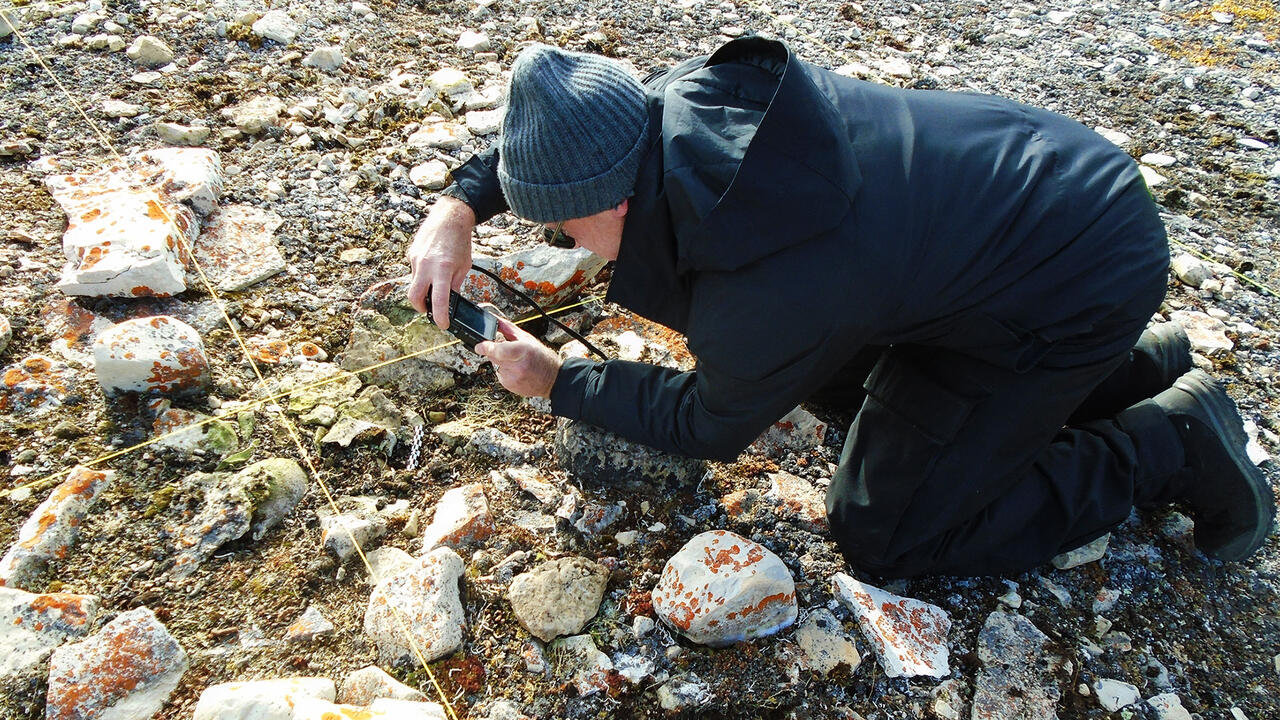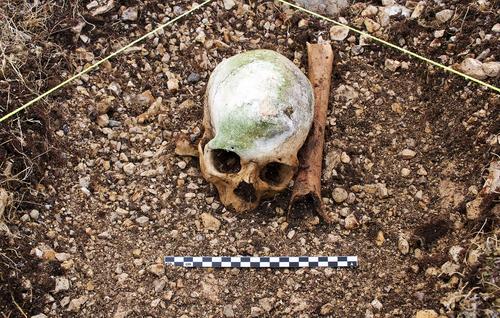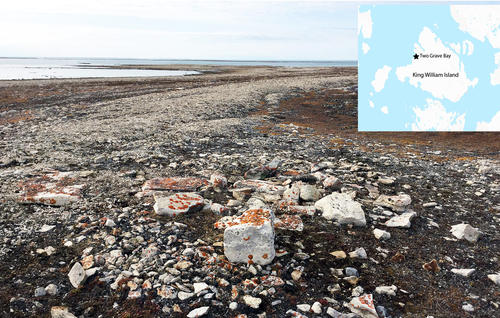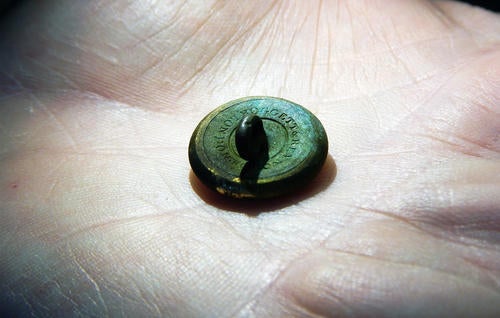
Waterloo researcher finds remains of Franklin Expedition officer
Professor Douglas Stenton uncovers long-lost grave on Nunavut’s King William Island.

Professor Douglas Stenton uncovers long-lost grave on Nunavut’s King William Island.
By Wendy Philpott Faculty of ArtsWhile the University of Waterloo’s research connections to the ill-fated Franklin Expedition began in 2008, it may have been the on-location Arctic coverage by CBC host Peter Mansbridge in 2012 that put a spotlight on the work. Mansbridge unearthed an 1840s toothbrush on camera as anthropology professors Douglas Stenton and Robert Park led the CBC host on a tour of one of the Franklin expedition archaeological sites they were investigating.
Then, in the summer of 2014, the two researchers were surveying an island in Wilmot & Crampton Bay with Canadian Coast Guard pilot Andrew Stirling assisting, when Stirling found part of a 19th century ship’s davit (crane) that supported Inuit oral history about a ship in the same area. That find was the major breakthrough that led directly to the discovery by Parks Canada of HMS Erebus the very next day, making worldwide news.

Human vertebra (on left side of cranium), cranium and femur found in grave at NhLh-12. These and other bones were collected from the surface of the site by the Schwatka search expedition and reburied on July 17, 1879. Photo credit: Douglas Stenton, Government of Nunavut.
Now, during his 2018 research trip, Stenton has rediscovered the remains of one of Franklin’s crewmembers on King William Island near Two Grave Bay. This was where, in July 1879, a Franklin search led by US Army Lieutenant Frederick Schwatka found the graves of two members of the Franklin expedition. Schwatka was one of many who searched for answers to the Franklin mystery, and the skeletal remains Stenton found in 2018 had been reburied by Schwatka 139 years earlier.
However, the precise location of the grave was unknown. “We know from historical records that Schwatka found the original burial badly disturbed and that skeletal remains from the deceased had been scattered widely around the grave,” said Stenton. “Schwatka and his party gathered together the remains they were able to find, placed them back in the shallow grave and erected a prominent stone monument over the grave, which was subsequently dismantled.”

Remains of disturbed Franklin expedition grave (c. 1848) and dismantled monument (1879), Two Grave Bay, King William Island, Nunavut. Photo credit: Douglas Stenton, Government of Nunavut.
With no visual marker, other factors led to this summer’s rediscovery, explains Stenton, who retired in 2017 as Nunavut's Director of Heritage. With Schwatka’s 1879 expedition map, he decided to make a new search with the help of more precise modern maps.
“I didn’t assume the grave would be easy to find, but it seemed possible in this particular case to really narrow down the search area, and so I made it a priority for 2018.”
A critical clue was in Schwatka’s account of gilt buttons in the grave, and Stenton guessed that if they were still there, the unmarked grave could be identified by using metal detectors, “which, in fact, is how it was found on our first day of fieldwork.”

Close-up of maker's mark - BOGGETT & REYNOLDS × LONDON - on back of gilt button. Photo credit: Douglas Stenton, Government of Nunavut.
In the grave, Stenton found a skull, a mandible (jawbone), part of a pelvis, a femur, several vertebrae, and a few bone fragments. Interestingly, none of the clothing artifacts (11 buttons, pieces of buckles, and fragments of fabric) were found with the skeletal remains, but were around its perimeter, suggesting that the site has been disturbed by animals and humans over the past 139 years, said Stenton. He agrees with Schwatka’s identification that the deceased was likely an officer given “the gilt buttons and belt buckle pieces are from an officer's uniform.”
Now the detailed examination of Stenton’s rediscovery begins. The clothing artifacts are at the Canadian Conservation Institute in Ottawa for assessment and treatment, and the skeletal remains were recently in Robert Park’s lab here at Waterloo. Park’s work included 3D imaging of the skull, jawbone and teeth for 3D printing, and from the full skull model, a forensic artist will potentially reconstruct the officer’s face. From Waterloo, the remains have been sent to Trent University for examination by Stenton and Park’s colleague, Dr. Anne Keenleyside, whose analysis will estimate age, indicate disease, and extract DNA samples. Finally, next summer the remains will be returned to King William Island and reburied (for the third time) at the site where Stenton found them.
Reconstructions of events that occurred during the final stages of the Franklin Expedition have relied on documented and oral historical sources.
“Those records are critically important,” said Stenton, “but new archaeological investigations can also play an important role in evaluating interpretations and hopefully contribute to a better understanding of events surrounding the fate of the Franklin expedition.”
Banner photo: Douglas Stenton documenting human skeletal remains in grave of Franklin expedition officer, Two Grave Bay, King William Island. Photo credit: Andrew Stirling.

Read more
Researchers awarded funding to investigate ecology, climate change, repatriation, health and well-being through cultural and historical lens

Read more
New Canada Research Chairs will tackle future-focused problems from social robots and intergroup attitudes to geochemistry and nanoscale devices

Read more
Meet five exceptional Waterloo graduate students crossing the convocation stage as Class of 2025 valedictorians
The University of Waterloo acknowledges that much of our work takes place on the traditional territory of the Neutral, Anishinaabeg, and Haudenosaunee peoples. Our main campus is situated on the Haldimand Tract, the land granted to the Six Nations that includes six miles on each side of the Grand River. Our active work toward reconciliation takes place across our campuses through research, learning, teaching, and community building, and is co-ordinated within the Office of Indigenous Relations.